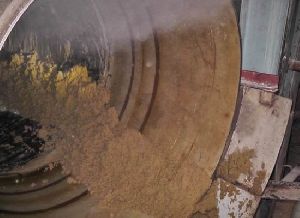
Sulphited Juice Screening System
In a normal milling plant the feed juice temperature is much below 35 – 40 Deg C and hence the total Rotary juice screen assembly is of “open” feature, i.e. top and discharge end drums are open to atmosphere. However, considering the temperature of hot juice at 70 – 80 Deg C, it is essential to provide Rotary Screen with our unique feature of “totally enclosed” arrangement to avoid heat losses and to prevent subsequent reduction in temperature of screened juice. In order to prevent escaping of vapours the Rotary Screen is provided with totally closed bolted top cover and totally enclosed feed and discharge end drums. In addition to totally closed construction of Rotary Screen it is essentially required to provide lagging followed by aluminium cladding to all stationary parts of Rotary Screen to avoid heat loss. Hot – raw or suphited or defecated (limed) juice screening process using Rotary drum screen: A) Hot raw sugarcane screening: Sugarcane hot juice resulting from raw juice heaters i.e. either shell and tube type, plate type heat exchangers and Direct contact type heaters containing suspended fiber particles fed to hot raw juice screening system. Screened sugarcane raw juice from rotary screen is collected in slopped bottom trough for onward transferring directly to juice reaction vessel (sulphitor or defecator) or in some cases shall collected in receiving tank by gravity for onward pumping of sugarcane hot juice for sulphitation or defecation (liming) process. The fiber / suspended matter separated at sugarcane hot juice rotary screen is discharged into the mud tank again by gravity or collected in slurry preparation tank to be pumped to mill station. B) Hot sulphited or defecated sugarcane screening: Sugarcane hot sulphited or defecated juice resulting from reaction vessel i.e. either sulphitor in case of direct consumption white sugar production and defecator in case of raw sugar production, containing suspended fiber particles fed to hot juice screening system. Screened sugarcane sulphited or defecated juice from rotary screen is collected in slopped bottom trough for onward transferring to sulphited or defecated juice receiving tank by gravity for onward pumping of sulphited or defecated screened sugarcane juice for further heating process. The fiber / suspended matter separated at sugarcane hot sulphited or defecated juice rotary screen is discharged into the mud tank again by gravity or collected in slurry preparation tank to be pumped at mill station.
...more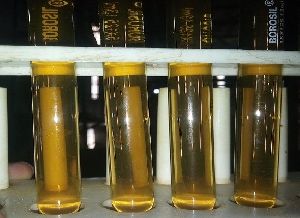
Rotary Screen
Clear sugarcane juice resulting from settling clarifiers i.e. either 4/5 compartment conventional clarifier or short retention single tray clarifier containing suspended fiber particle fed to clear juice screening system. Screened sugarcane clear juice from rotary screen is collected in slopped bottom trough for onward transferring to clear juice receiving tank by gravity for onward pumping of sugarcane juice for concentration process. The fiber / suspended matter separated at sugarcane clear juice rotary screen is discharged into the mud tank, again by gravity or suitably disposed off. The efficiency of clarifiers at the sugar industry is critically important in ensuring good sugarcane clear juice quality without suspended matter, which in turn is necessary for good sugar quality. Separation of suspended solids at clarification house of thin juice in sugar industry is currently done using the multi tray or short retention single tray clarifiers. From last 5 to 7 years as preparatory index of sugarcane at milling station found improved in order to extract more sugar, more quantity of fine suspended particles were observed in clear juice. These suspended particles / fibers responsible for increasing the colour of final product also adversely affect the keeping quality. After conducting the analysis at several sugar factories in India and abroad the quantity of suspended fibers in clear juice found as high as upto 100 ppm and sometime more.
...more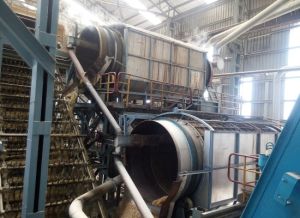
Rotary Juice Screening System
At the outset, thanks to mill engineer colleagues, sincerely appreciating their consistent and best efforts to maximize the P.I. of prepared sugarcane indeed for the good reason and with the good intention of further improving mill extraction performance and surely which is “A need of the Time”. However it is being observed that well prepared sugarcane with the long thread like formation of sugarcane fiber at sugarcane preparatory device for rupturing of sugarcane cells is already a story of the past and that, more and more powdered dust like formation of sugarcane fiber is unintentionally and unavoidably found to be occurring in almost all sugar factories. It is later observed that higher quantity of this finely pounded fiber is found to be escaping through 0.45/0.5 mm wedge bar opening which indeed is a universally accepted or opted norm of wedge bar gap by cane-sugar industry all over world. This resulted into creating serious processing problems at clarification house as well as causing mechanical problems like choking at pumps, Juice heater headers and at wide gap PHE. The problem was found further aggravated when these fine light weight fiber particles started appearing in sugar-cane clear juice the phenomena which was very rarely used to be observed in earlier times so much so that the final product white sugar was also found containing these fiber particles thus seriously deteriorating the quality of plantation white sugar due to sugarcane fiber contamination. It was then felt necessary by cane-sugar industry that to provide ‘prior’ fool proof preventive measures for the effective separation of these fine sugarcane fibers at milling station or sugar cane diffuser where sugar from sugar-cane is extracted and never to allow them to enter into sugarcane juice clarification house at all. At the same time the system should be “cost effective” allowing immediate and forever recurring returns.
...more
Rotary Juice Screen
Technology Solid / liquid separation is effected on a welded wedge bar screen drum mounted in horizontal position with appropriate slope towards non-drive end. The diameter, the length of the screen, the speed of the rotating screen and its inclination are well designed to facilitate complete drainage of juice. Maximum juice is separated in feed section of the screen. Special design feature also includes cleaning the screen periodically by automatic application of hot water through flat cone nozzles which ensures clean screen surface throughout the operation period. Construction A cylindrical rotary drum fabricated in S.S. construction is fitted with rim / tyre located on either end for mounting the entire drum assembly on trunnions. The screening area comprises of welded wedge bar screen drums joined together by bolting arrangement. Towards the drive end side of the end drum the driving sprocket is rigidly fixed on output shaft of gearbox and connected to driven sprocket mounted on rotating drum to transmit the power through heavy-duty chain arrangement. Thrust rollers fitted at the non-drive end absorbs the lateral thrust developed by inclined rotating drum. The entire assembly of the drum along with its trunnions is mounted on fabricated frame. Flat cone stainless steel spray nozzles are fitted on stainless steel piped header located on the framework of side hood to cover the entire length of screen drum. The drum along with screen is shop assembled and empty trial run of continuous 48 hrs. is conducted at workshop prior to dispatch. Operation The unscreened juice containing suspended solid particles comprising fine and coarse bagasse particles enters continuously from drive end of the drum through a distributor. The screened juice is collected in the sloping half cylindrical shape bottom trough for quick removal of screened juice to screened juice receiving tank. The solid mass keeps on rolling on the wedge bar screen and during its forward movement towards non-drive end the remaining juice is also drained away leaving the solid mass on the screen which is discharged to cane / bagasse blanket by gravity. Capacity and sizing Our production range offers design and manufacture of ONE single unit to suit upto 12000 TPD cane crushing capacity. For diffuser unit of extraction, a “totally closed” and fully insulated version of RJS is used to avoid the thermal loss that may occur due to hot draft juice and press water. This featured rotary screen is also used for Hot Melt Liquor Screening in refinery.
...more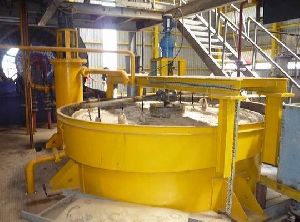
Melt Clarification System
The syrup resulting from evaporator station contains various organic matter in colloidal form and colouring matter derived from clear juice added with colouring matter further developed during evaporation and as such needs special attention for removal of various impurities so that the final product i.e. plantation white sugar will have minimum colouring matter adsorbed in the inter crystalline layers. While syrup sulphitation gives a bleaching effect and many more multifold advantages it has now become generally adopted practice to resort to a syrup clarification system which can consistently produce sugar of colour value much less than 100 IU. Syrup Clarification System is also used for producing raw sugar of much better quality. Operation Calcium Tri-phosphate is universally known as best colour adsorbent and obviously the first step in the system is production of calcium tri-phosphate by treating the syrup with lime sucrate and phosphoric acid in a specially designed reaction vessel to accomplish the reaction with provision of optimum reaction time for completion of the reaction. The next step is aeration of the syrup by inducing micronized air which by virtue of its fine size adhere to calcium phosphate precipitate and other insoluble impurities. In the specially designed floatation clarifier the air bubbles are allowed to have a shortest path to the surface and the clarified syrup is withdrawn at the silent zone. The air bubbles after reaching to the surface burst into air and the scum which is accumulated on the top of the surface is continuously pushed by raker arms into scum channel. In order to activate the floatation phenomenon a floatation polymer which enhances kinetics of floatation is added prior to clarifier. Although major part of colouring matter gets adsorbed in the calcium tri-phosphate the part which still remains in the soluble form is precipitated by effectively mixing with de-colorising agent. The beauty of our system is that it is independent of any proprietary chemicals and as such there is no dependence on a particular brand. This further allows economic level of chemical consumption. This clarification method is adopted for sugar melt clarification as well, by incorporating appropriate design features. Process automation at Syrup and Melt Clarification The system is provided with complete PLC based process automation compatible to DCS/SCADA in respect of uniform flow, pH control and controlled addition of all chemicals w.r.t. flow rate. The electric motor drive of chemical dosing pumps are provided with VFD. The chemical is added in proportion to flow rate. The signal of flow meter is fed to ratio controller as input and the output of ratio controller is fed to VFD to vary the speed of pump for automatic dosing of chemicals at a pre-set value. At floatation clarifier by virtue of difference between density of syrup or melt and that of scum containing insoluble solid impurities which are closely attached to fine micronized air bubbles the solid / liquid separation is effectively achieved. However if further fine separation is desired for removing even the negligible quantity of very fine micron size particles then syrup or melt is subjected to fine filtration in a closed semi pressurised vessel provided with multi layers of assorted size gravel media layer initially of relatively higher size of say 20 mm and finally through 1.5 mm anthracite layer. The total cycle operation of inflow, run, back wash etc. are fully automated using PLC/DCS/SCADA based controls. These filters prove very useful for producing refined sugar and also for production of value added plantation white sugar.
...more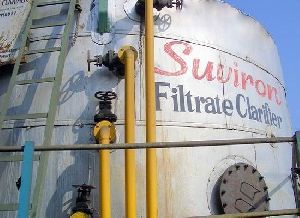
Filtrate Clarification System
Our system of filtrate clarification works on sedimentation principle. We strongly believe that the “fundamental principle” of any filtrate clarification system should be – “the clarified filtrate should go directly to evaporator”. By virtue of technology involved in filtrate clarification system used elsewhere i.e. “phospho Floatation” it is practically impossible to produce clarified filtrate worth of desired quality to be directly sent to evaporator. This is what precisely happens with this floatation type technology being in use at several places. The critical deep study of this system and its failure to follow the “fundamental principle” rightly motivated us to invent the other only method of solid/liquid separation which is essentially “sedimentation” process. First and foremost, the clarified filtrate from filtrate clarifier goes directly to evaporator station. In “Sedimentation Process”, 100% suspended impurities are removed. Salient Features The clarity of clear juice resulting from filtrate clarifier is of superior nature and free from any suspended particles. ICUMSA colour value quite comparable with clear juice resulting from main juice clarifier. The purity rise from filtrate to clear juice is found in the range of 2 to 3 units. No increase in CaO content from filtrate juice to clear juice. In fact there is reduction in CaO content as actually observed. The mud resulting from clarifier is found to be quite compact and the thick mud is obtained resulting into better performance at vacuum filter. Due to separate treatment of filtrate considerable reduction in re-circulation of sugar as well as non-sugar is observed. Increase in the capacity of existing clarification house to the extent of 15 to 20% Increase in boiling house recovery due to increase in purity of filtrate juice to clarified filtrate juice. Improvement in colour value of sugar as good amount of coloured non sugars get precipitated at filtrate clarifier. Independence on any specialized proprietary chemicals as the process needs only conventional chemicals which are available at any sugar factory. As practically observed at our installations the keeping quality of the sugar found to be improved Very ideal for 25-30% plant expansion programme.
...more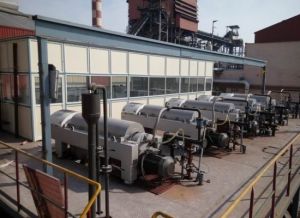
Decanter System
Introduction The obsolete plate / frame type filter presses for full juice filtration were eventually replaced by rotary vacuum filter which long stayed in the Indian sugar industry almost for last sixty years!, inspite of various associated problems; perhaps for the reason of simplicity and more importantly for the reason that no better alternative technology was readily available. Construction The Solid bowl decanter technology has gained wide application in industries like oil, dairy, chemical, water and sewage treatment etc. and is in existence for more than a century all over the world. The growing awareness of power for sustainable growth of sugar industry in fact has been a driving force to look out for alternative technologies requiring less power and diverting more than 1.0% cane of bagasse for additional electric power generation. Technology Unlike the conventional centrifugal machine used for separating sugar crystal from mother liquor either in batch or continuous where mother liquor by application of centrifugal force passes through the screen openings, the decanter although is centrifugal machine does not have any perforations over the rotating basket. The basic principle of using centrifugal force for solid/liquid separation is universally remains the same. The only difference is that the insoluble solids when subjected to centrifugal force get separated from liquid towards inside surface of bowl and are continuously pushed towards discharge end by a rotating helical scroll. The cake is continuously discharged through discharge ports fitted with tungsten carbide bushings. The decanted juice is continuously taken out through a concentric opening.
...moreBe first to Rate
Rate ThisOpening Hours